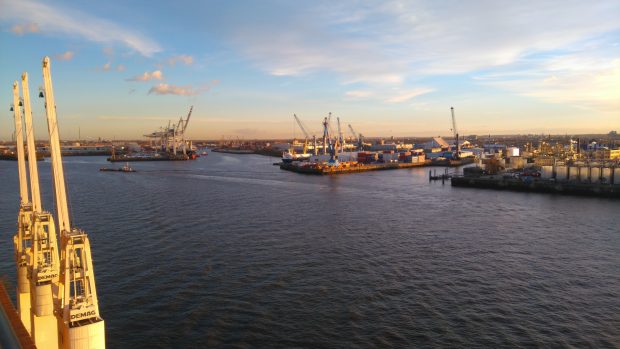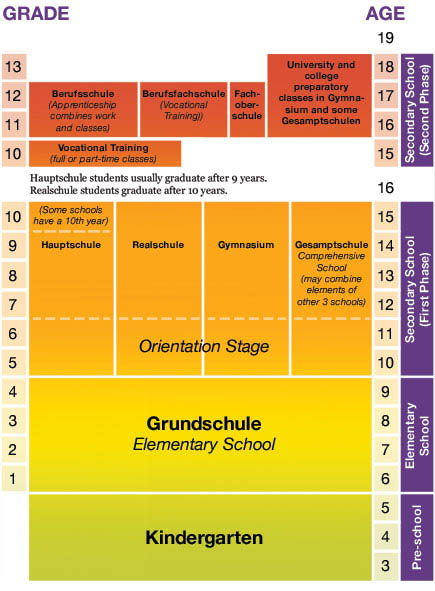By Lauren Thompson
On a whim, I applied to a conference in Gothenburg, Sweden to encourage myself to write more of my thesis. Shockingly I was accepted and began to plan my trip to Scandinavia. Since my partner, Sam, would be visiting at the time and we had both never been to Sweden, we decided to visit Stockholm first before making our way southwest to Gothenburg.
Our trip was the last week of November, so the weather had begun to get chilly, the days shorter, and the Christmas season was beginning in Europe. We even managed to hit one Christmas market in my town, Harburg, before flying to Stockholm.
Stockholm is wonderful and for our first two evenings we stayed at the AF Chapman hostel. The most unusual feature of the hostel is that a good portion of it is located on a steel sailing ship moored in central Stockholm, on the island (islet? That is what Wikipedia calls it) of Skeppsholmen. The ship, the AF Chapman, is the hostel’s namesake and was surprisingly cozy for staying belowdecks, though many doorways (and ceilings) were too short for Sam, who is 6’6”.
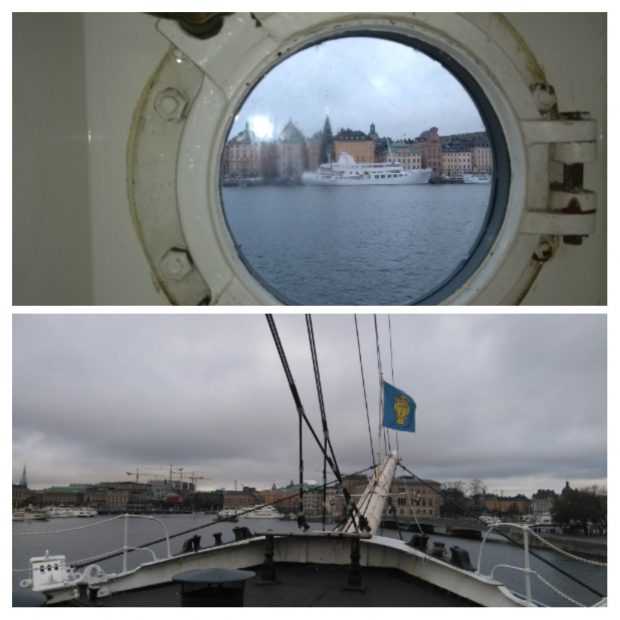
Our trip back in time also proved to be quite an adventure in short ceilings. One of our first tourist sites was Skansen, an open-air museum located on Djurgården island – also home to the Vasa Museum (the ship that sailed for less than 30 minutes before sinking off the shores of Stockholm) and the Nordic Museum among other attractions. Open air museums typically aim to show typical life how it used to be by allowing visitors to explore buildings from that time (often transported to the museum from their original location), talking to employee-actors, and seeing the manner in which people lived and the types of items that were created (machinery, trades and crafts are featured). Skansen has a wide variety of eras from Swedish history as well as displays of Sami culture and construction.
We arrived on the first weekend of Jul på Skansen, “Christmas at Skansen”. Alongside Swedish Christmas traditions and the foods and music showcased at the variety of farmhouses and estates, there was a Christmas market – one of my favourite parts of winter in Europe.
The Christmas market featured a wide variety of foods, drinks, and crafts. Although I am typically vegetarian, I tried a reindeer sausage to get into the spirit and we drank Glögg, Swedish-style mulled wine. We purchased large, hand-made knäckebröd (like Wasa crackers), some smoked fish, and also some presents. I bought a number of decorations as gifts and for myself, these included the traditional Swedish horse, mushroom ornaments, and Tomte – the Christmas gnomes or elves. Sam purchased a beautiful three-wick candle that resembles a trident which he managed to transfer back to Canada with only a minor crack! The Christmas music, the cold air (it was between 0-1°C that day), the fires that were lit when it started to get dark at 2:30pm, and all the smells and sights were delightful and festive.
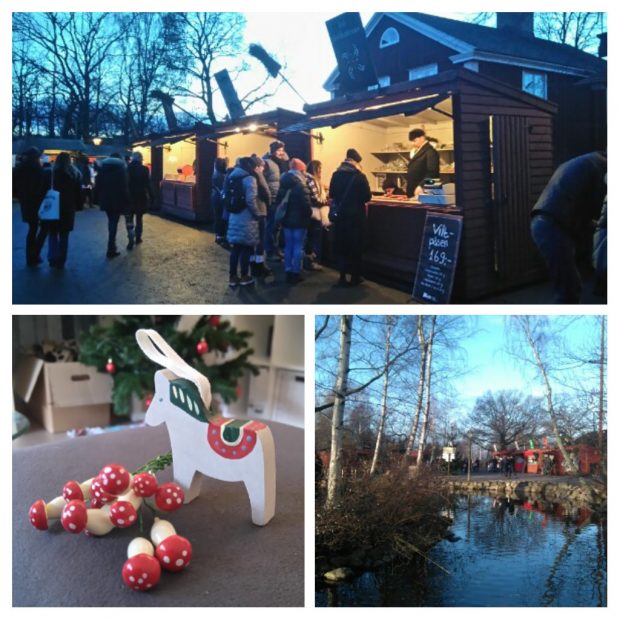
Skansen Christmas market and Skansen purchasesSkansen has a number of different eras and regions represented in the buildings it has on the property. I won’t go through all of them but choose some highlights that were open when we were there (parts are closed in the winter).
Farmsteads make up many of the buildings at Skansen. Since they come from different areas and from farms of different wealth, they have unique features. You can visit the interior of many of the buildings (entering through low doors where Sam would have to duck generously). Many of the rooms would have an actor or two dressed in traditional clothing that would have been typical for the inhabitants of that region, time, and stature. You can interact with them and they would talk about how their character would live. During our time at Skansen, they showed the traditional Christmas meals as well. Below is an image from a mural in the Delsbo farmstead originally from Hälsingland.
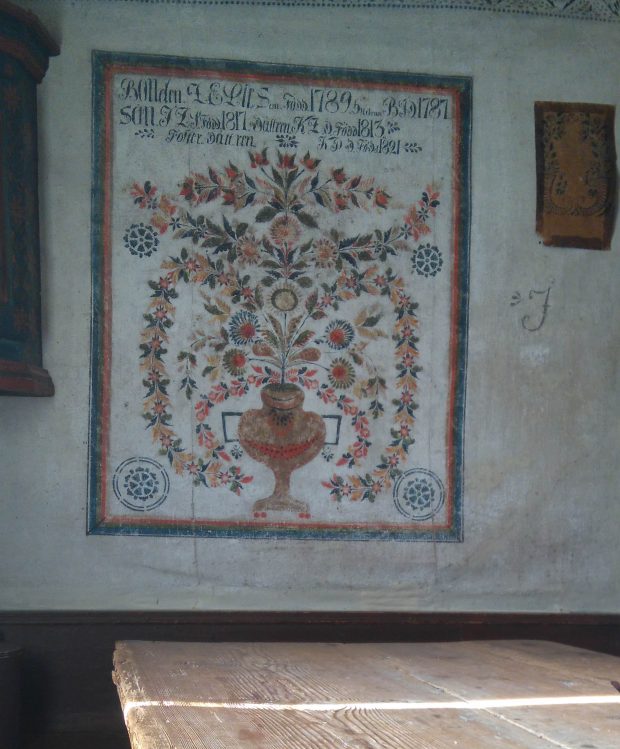
There is also a town within Skansen that contains all kinds of trades – an engineer, glassworks, furniture-maker, bakery, comb-maker, goldsmith, printer, etc. etc. etc. Since Sam is a carpenter, we spent a fair while in the furniture-makers. My favourite machine had to be the pedal-powered scroll saw – if I should ever start a collection, I will buy one. Those working in the town were also practicing those trades – so there were people blowing glass ornaments, baking Lussekatter (traditional Swedish Christmas treats), making shoes, and creating prints. It took all of my will-power not to buy some beautiful glass Christmas ornaments that would have broken just on the trip back to Hamburg.There is also a Sami (Laplander) camp that shows architecture from the indigenous Sami people in Sweden. Sami have a unique language and way of life that was earlier connected to reindeer herding. Since many Sami were semi-nomadic, some of the buildings in the camp were seasonal buildings only used in the summer.
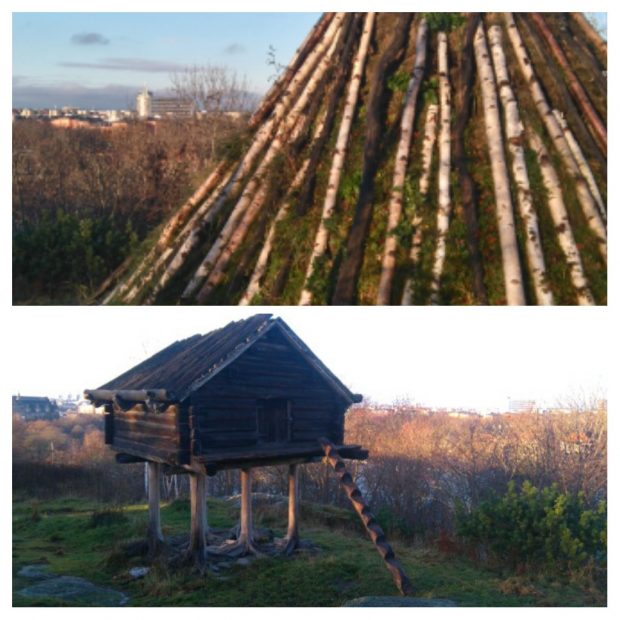
Finally – Skansen also has a zoo and aquarium. The aquarium costs extra but you could still see many of the zoo animals (kept in generously large areas with lots of variety) on one side of the museum. These included owls, reindeer, seals, wolves, and my favourite – Otters, among a few others. Some animals were also in hibernation since it was winter, but it was fun to see the otters playing and the reindeer being very chill.
Unfortunately, the otters were moving too fast for me to get a good picture.
One thing that was a bit shocking and causing restraint throughout Sweden was the prices. I am currently used to German prices for food which are comparable, if not sometimes less, than in Canada. But in Sweden it is often 5-25% more for products than in Canada – I definitely at one point paid the equivalent of $14 for one beer at a restaurant. The prices at Skansen weren’t different, but we were still able to enjoy ourselves and find some decent deals there – not to mention some free flat-bread snacks at the bakehouse.
There is so much more at Skansen that I haven’t been able to mention. Including the beautiful views that you get of Stockholm from the top of the hill there. We only went for one day, but I feel like I will return in the future to experience more of the expansive museum! It is definitely to be recommended if you find yourself in Stockholm.
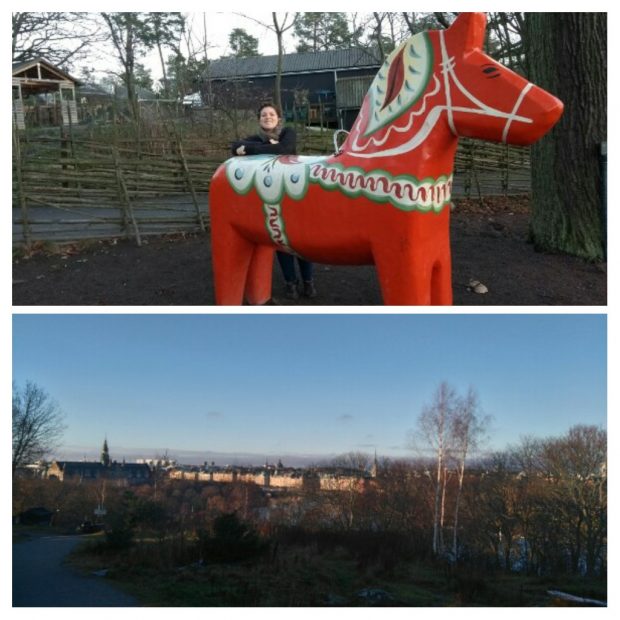
Best Holiday wishes from Northern Europe! Until next time, friends.
Lauren

